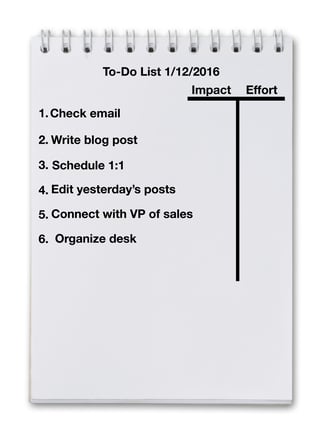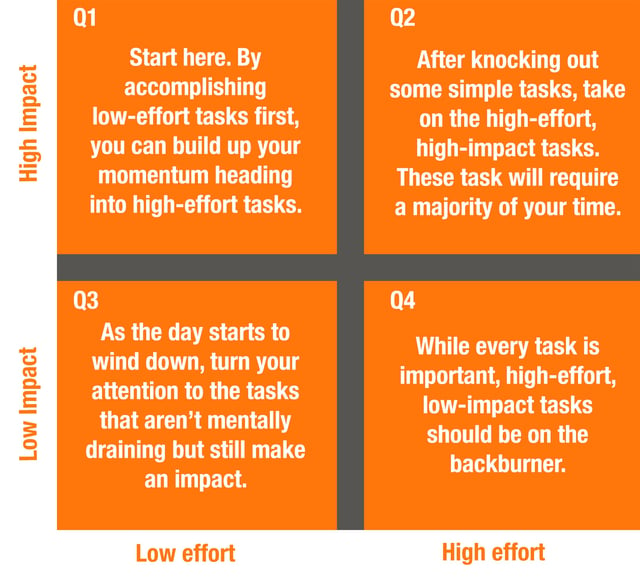

We all want to be as efficient as possible but that can be a challenge -- especially if we have an overwhelming to-do list.
So how do we determine which tasks on our to-do list are most important? Some productivity experts advocate for “eating the frog” and doing your most difficult task first. Others theorize the “two-minutes or less” approach is the best tactic.
But if neither of those work for you, I might suggest trying a new technique: the impact vs. effort analysis. Before you begin a task, ask yourself: How much effort will this take and what will the immediate impact be?
Running an impact vs. effort analysis allows you to quickly determine which of your tasks is going to have the most immediate impact in the least amount of time. For example, there are times during the day when my inbox is overflowing but I have a blog post to write. What should I tackle first?
A quick impact vs. effort analysis reveals that getting through 30+ emails takes a significant amount of effort, but has little impact on my success. Writing a blog post, however, requires more effort, but carries a much higher impact.
Want to prioritize your to-do list quickly and correctly? If you have two minutes to spare, run an impact vs. effort analysis following the steps below.
How to Conduct and Use an Impact vs. Effort Analysis
1) Write down your to-do list.
Writing down a to-do list allows you to determine the most important five to 10 tasks you have on a given day. Studies show when we write down our goals, we're more likely to achieve them. With a clear list, we don’t have to waste time thinking about what’s next.

2) Rank the tasks on impact and effort.
Go through each of the tasks on your to-do list and rank them on both impact and effort. Based on these rankings you can determine which tasks on your to-do list are the most crucial. Rewrite your to-do list based on this analysis.

You'll end up with four distinct types of tasks, which you can plot on the quadrant below:

3) Start with the high impact, low effort goals.
By focusing on the high impact, low effort goals first, we can establish some success early in the day, making the high effort goals easier to accomplish. Studies have shown that by accomplishing a multitude of small goals, we are more likely to complete larger goals.
4) Then conquer high impact, high effort goals.
Once you’ve built up enough steam completing your high impact, low effort goals, move onto your high impact, high effort goals. These tasks are going to be more difficult, but their impact means that they need to be dealt with as soon as possible.
5) Next, focus on your low impact, low effort goals.
After a long day of making waves, turn your attention to your low impact, low effort goals. For example, this is the perfect time to respond to emails and clear out your inbox, organize your desk, or set up meetings for the next week. Low effort, low impact goals are easy wins, and as I pointed out earlier, easy wins add up to larger wins.
6) Finally look at your low impact, high effort goals.
Tasks that require hard work but offer little benefit will arise from time to time. When it comes to low impact, high effort goals, focus on chipping away at them over time as opposed to tackling them all at once. By doing this, you will achieve these goals over time without losing the necessary energy to make a high impact every day.
For an easy visual reminder of how this system works, keep the following quadrant handy:

Being productive comes down to managing your time as best as you can. By running all of your tasks through an impact vs. effort analysis, you can weed out unimportant ones and focus your attention on the critical goals you have for each day.










